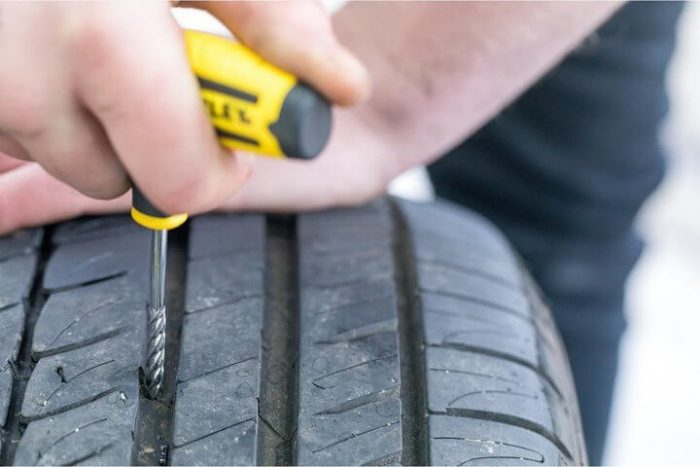
More often than not, it’s our fault that our tires go bad. But this can be avoided. Tires can be damaged in a variety of ways during use, most of which is the driver’s fault. As a result, the tires go to waste, and since legislation prohibits the use of different models of tires on the same axle, you have to spend money on replacing the second tire as well.
The most common damage is a puncture. This is the most harmless type of damage, but only if you noticed it in time and repaired it right away. It is absolutely forbidden to drive on a flat tire, not even for a couple of meters! The damage caused by driving on a flat or low-pressure tire is catastrophic. This causes the sidewalls to deform more than they should, causing the tire to overheat, delaminate, and the carcass to deteriorate due to broken cords. The result is that the tire has to be scrapped. In addition, you can also damage the rim of the wheel.
A car tire has a complex structure and a specific composition of rubber compound, which protects the tire from shocks, and keeps its shape under high loads. The structure of the wheel consists of several frameworks of strength – metal wire and Capron thread, they hold the rubber on the trajectory during intensive and dangerous driving.
Any type of damage can have negative consequences that affect driving safety and stability on the road. And while most punctures can be repaired at the service station or repaired with your own hands, a lateral tire cut often forces you to resort to the complete replacement of the tire.
Not every tire that encountered a nail, rebar sticking out of the ground, or a sharp stone on the road is considered to be ruined. Everything, of course, depends on the extent of the damage and its location on the tire itself. Some can be repaired easily, while others are simply impossible to do – the tire can only be sent to the trash.
Below we will consider the most common types of wheel damage, with an emphasis on whether the wheel can be repaired after them.
A bump

A swollen tire called a bump or hernia among drivers is the most common tire sidewall defect. It appears due to collision with an obstacle or after hitting a hole, more often at high speed. The threads of the sidewall carcass are easily damaged by the impact, and the tire at this point can no longer hold the load and air pressure – a swell appears. A small bump sooner or later turns into a big one, and driving with such a defect is dangerous – a wheel can shoot out at any moment. At high speed, it is fraught with loss of control, flying off the road, and overturning.
Some types of hernias are repairable, though it is a temporary measure. No patch can restore the factory stiffness. Ideally, replace the tire. Special cord patches can extend the life of a tire with a hernia, even if the bloat appeared on the tread.
The sidewall is a different story. If the swelling is over 40mm from the bead, it can be repaired. If not, the tire must definitely be replaced. Swellings on low-profile tires are most often beyond repair.
Breakdown of the side ring
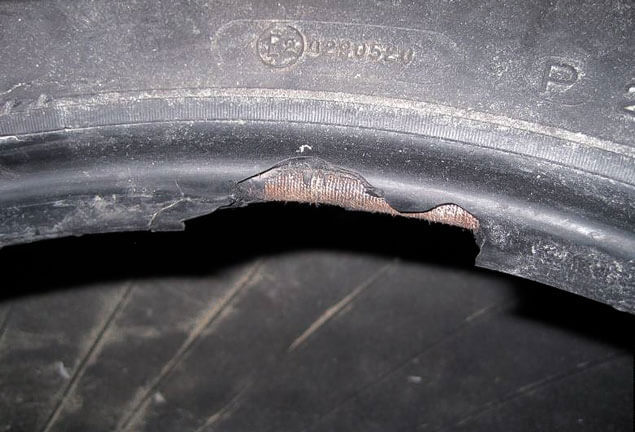
Cuts and hernias are not the only possible damage to the sidewall of a tire. It is also possible to ruin a sidewall ring, for example during a re-shoeing process. And it is no exaggeration to say that such a tire is already dangerous. Sooner or later, the pressure in the tire and the load in motion will start to squeeze the rubber from the rim – the wheel can explode.
Repair of this affliction is taken if the wire ring – the base – is intact. There are no special technologies and materials for fixing this very problem, but most often masters use a two-component chemical vulcanization compound.
If the side ring tears are barely noticeable, but the wheel is still flat, you can use a special liquid – a sidewall sealant designed for sealing tubeless tires.
Punctured tire
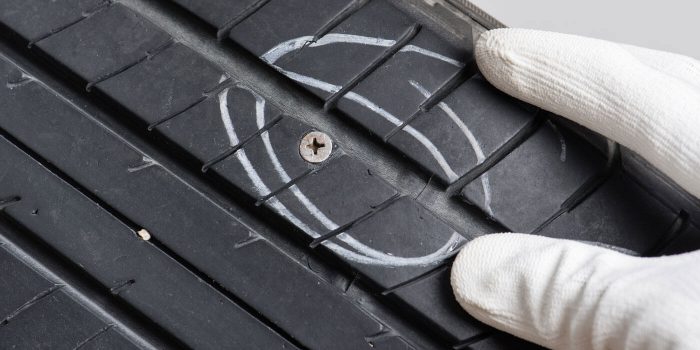
Perhaps everyone has faced this problem. Car tire puncture repair with their own hands will not be difficult, even on the road. But you need a pump (or compressor) and a universal tire repair kit with harnesses. All these things are sold at any auto market or gas station.
Side cut
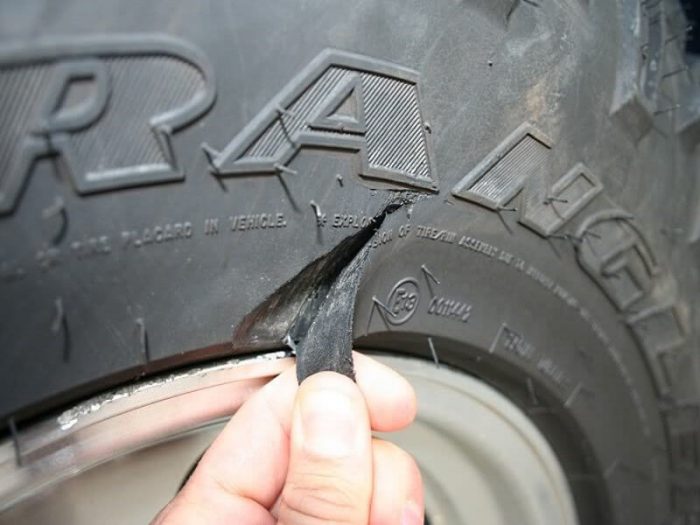
Elimination of a side cut is a serious operation, so, as in the case of a bump, you’ll have to go to the professionals. Cord patches are needed, nowadays they are available in different sizes and with different numbers of layers. And you can’t do without special tools and vulcanization.
The cut, by the way, can be healed not in all cases. If the tear is in the area of the shoulder of the tire, it is unlikely that anyone will undertake to repair it, since no guarantees can be given here.
Low-profile tires can be repaired, but it is more difficult. A tear in the sidewall is easier to seal on tires with a medium or high profile.
Sometimes a cut is mistaken for a gouge. This is when the outer layer of the sidewall is caught on something sharp, and a tear is formed, but the carcass itself remains intact. There is nothing terrible in it, though the masters at the tire fitting shop successfully convince the drivers to repair the cut, for which they charge accordingly.
If a piece of rubber on the sidewall is left, glue it with an ordinary superglue (101). If it came off, it’s better to cover it with raw rubber and vulcanize it. Leaving the pluck exposed is not recommended, as the tire carcass, often consisting of metal-cord, will corrode quickly.
The structure of a tire sidewall
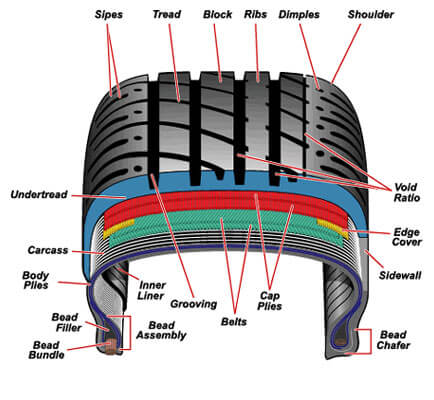
Before we start learning about tire sidewall casing, we need to understand what elements make up this part of the wheel. The sidewall of a tire has several layers of power cords to make it more stable. Note that the cord comes in many different forms:
Fabric – strands of strong synthetic;
Metal – filaments made of metal.
Both kinds of threads are used simultaneously in a cord, and they run parallel or cross each other in a layer. The main threads can also be arranged along the radius for radial tires. Diagonal tires have a filament that runs diagonally along the radius. Usually, several layers of cords are used at once. The outer layer of the sidewall is made of rubber.
If you get a cut, the cords are the first to get damaged. While the damage to the rubber layer can be repaired fairly quickly, damage to the cords can lead to the inability to continue using the tire. The more strands are damaged, the less chance the tire has to be repaired.
Sizes and types of side cuts
To determine how to fix a side cut, you need to look at the type of damage:
A longitudinal cut can be repaired and the seam sealed if it does not exceed 35 mm.A transverse cut can be effectively repaired if the seam is no more than 25 mm. Such limitations are due to severe damage to the threads. It is more difficult to glue and repair the tire with your own hands.
Sealing a cut on a tire is much more difficult than conventional repairs, so it is often necessary to perform forced tire replacement. Repairing the wheel is impossible because of the side wires and threads that tear under lateral loading. Taping and repairing the lateral damage will not repair the strands. Any obstacle or possible contact with a bump at high speed will lead to adverse consequences – the tire will burst because of the load, resulting in a dangerous loss of control.
It is worth considering the size of the damage. For trucks, the parameter is measured in the number of damaged threads, if there are more than 10 pieces, the tire is not restored.
It is possible to glue a longitudinal cut of up to 35 mm. In this case, there is no loss of strength. For transverse damage, the requirements are stricter and cuts of no more than 25 mm can be repaired. With cross-cutting, the threads are more severely damaged and this has a negative effect on the reliability of the tire.If the damage is closer than 40mm to the edge of the tire, it is not recommended to repair it.
Conclusion
We can’t help but remind you that most tire manufacturers do not recognize homemade tire repairs on their own. It is considered a sign of external influence and modification of the tire design. Such a tire automatically loses its warranty.
This does not happen if the tire is repaired by specialized, authorized tire brands. Note that almost all major tire brands give their extended warranty, which in most cases provides free, discounted, or generally a replacement of the product with a similar one, depending on the terms of the program.
It is also important to remember that in most cases, damage in the bead and shoulder area is not repairable.
